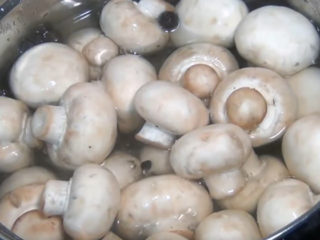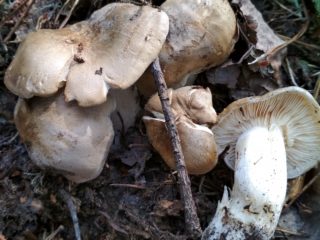Content
Hyfoloma cephaloforma is a member of the Strophariaceae family, genus Hyfoloma. The Latin name is Hypholoma capnoides, and its synonym is the term Nematoloma capnoides.
What does hypholoma capita look like?

This species grows throughout the summer and autumn, and can also be found even at the beginning of winter
The fruiting body of Hypholoma capitatum is presented in the form of a thin stalk and a lamellar cap with the following characteristics:
- At the initial stage of development, the cap is convex in shape with a blunt tubercle in the center; as it grows, it becomes flat. The surface is smooth, yellowish-brown in color with a greenish tint. As a rule, the color of the cap remains virtually unchanged throughout the life of the fruiting body.Old mushrooms often develop rusty-brown spots on the surface. The size of the cap reaches about 8 cm in diameter.
- On the inside of the cap there are adherent plates. Initially they are light, but as the mushroom matures they become gray or smoky. The spore powder is gray-violet in color.
- The stem of Hypholoma capitae is thin, no more than 1 cm in diameter, but quite long, reaching up to 10 cm in height. The surface is smooth, painted in a light yellow tone, smoothly turning brown to the base. The ring on the leg is missing, but often instead of it you can see the remains of a bedspread.
- The pulp is thin and brittle. When cut, it is whitish or yellowish, at the base of the stem it is brown. It has no pronounced aroma, but has a slightly bitter taste.
Where does Hyfoloma capitatum grow?

The mushroom grows in large groups
This specimen grows quite rarely in deciduous forests. Instead, it prefers to roost in pine meadows, piles of bark, or on wood husks. Also, Hypholoma capita can sometimes be found on pine or spruce stumps. This gift of the forest is quite frost-resistant. In addition to the fact that it grows throughout the summer, it can be caught by mushroom pickers in late autumn. Even with persistent frosts, sometimes there are frozen fruits that retain their appearance for quite a long time.
Is it possible to eat Hypholoma capita?
The gift of the forest in question belongs to the group of conditionally edible mushrooms. The nutritional qualities of Hypholoma cephaloforma are not particularly valued among mushroom pickers, which is why it is assigned only category 4. Only hats are recommended, since the legs are particularly rigid.This specimen is best suited for drying.
False doubles
In terms of external features, Hyfoloma cephaloforma is similar to the following forest gifts:
- Sulfur-yellow honey fungus - poisonous specimen. It can be distinguished by the yellowish color of the cap with lighter edges and a dark brown center. In addition, the pulp of the dangerous double exudes an unpleasant aroma.
The mushroom grows in large groups
- Summer honey fungus - belongs to the group of edible mushrooms. The fruiting body consists of a wide dark cap and a thin stalk. It differs from the species in question in its pleasant fragrant aroma with a honey note.
The mushroom grows in large groups
Collection rules
Collecting Hypholoma cephaloforma should be done with extreme caution, as it has a poisonous counterpart - the sulfur-yellow honey fungus. After the mushroom picker is convinced of the authenticity of the species, it can be carefully unscrewed from the soil, being careful not to damage the mycelium. The formed hole should be covered with moss or forest litter. The fruiting bodies of this variety are quite fragile, so they should not be placed in the same basket with their larger relatives.
Conclusion
Hyfoloma cephalosa is not particularly well known in Russia, but is popular in some foreign countries. This species is notable for its ability to survive even in prolonged sub-zero temperatures. But even frozen caps are suitable for consumption. First, they are heated, and then fried or dried.










